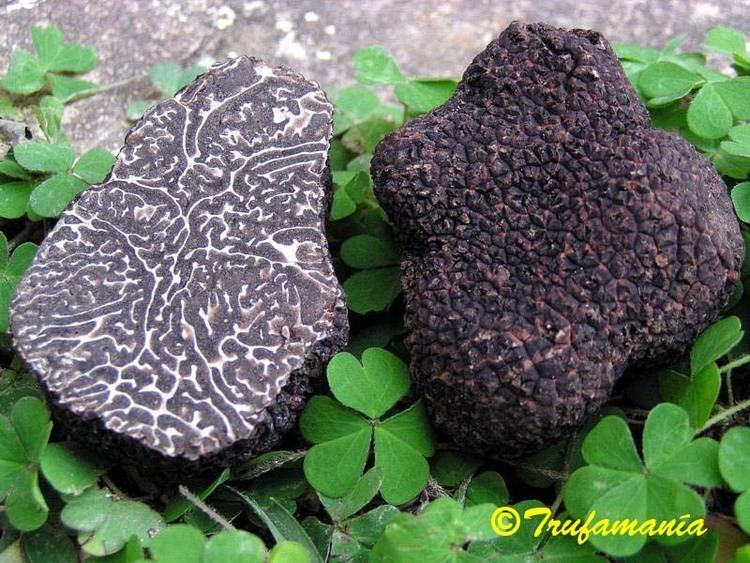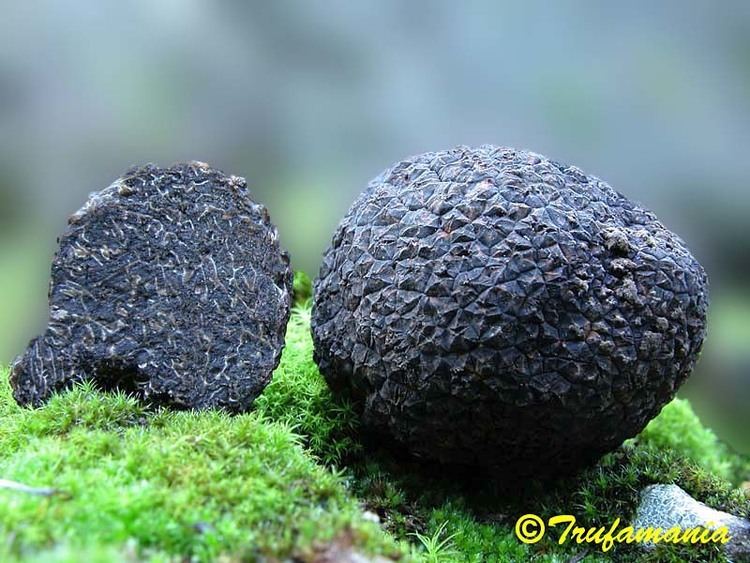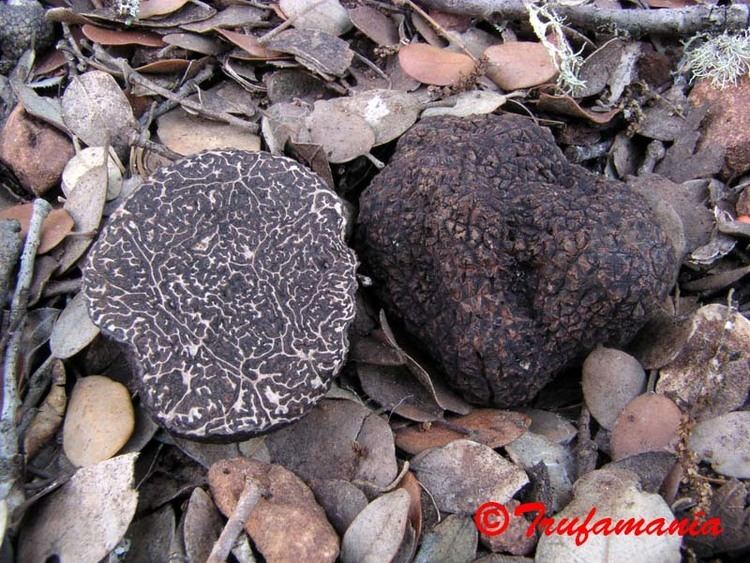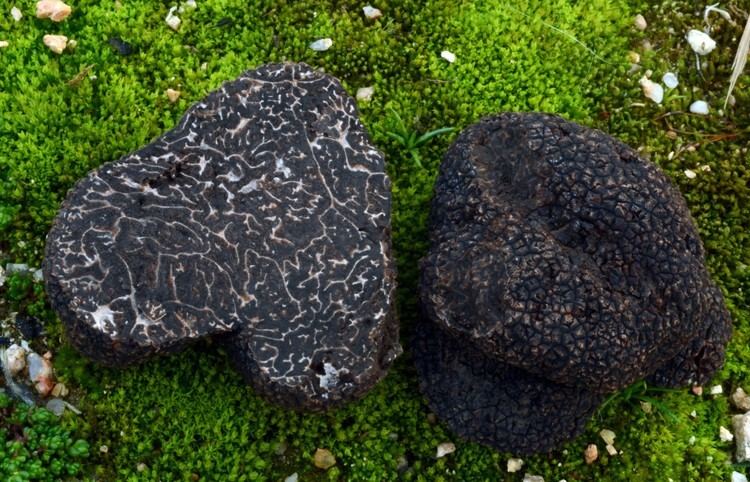Kingdom Fungi Subphylum Pezizomycotina Higher classification Truffles | Scientific name Tuber melanosporum Rank Species | |
Similar Piedmont white truffle, Truffle, Truffle oil, Foie gras, True ls | ||
Tuber melanosporum 2012
Tuber melanosporum, called the black truffle, Périgord truffle or French black truffle, is a species of truffle native to Southern Europe. It is one of the most expensive edible mushrooms in the world.
Contents
- Tuber melanosporum 2012
- truffle identification tuber melanosporum
- Taxonomy
- External characteristics
- Aroma
- Genome
- Identification
- Development and phenology
- Reproduction
- Habitat and cultivation
- Production
- Commerce and use
- Physiology
- References

truffle identification tuber melanosporum
Taxonomy
Italian naturalist Carlo Vittadini described the black truffle in 1831.
External characteristics

The round, dark brown fruiting bodies (ascocarps) have a black-brown skin with small pyramidal cusps. They have a strong, aromatic smell and normally reach a size of up to 10 cm (3.9 in). Some may be significantly larger, such as a black truffle found 2012 in Dordogne with a mass of 1.277 kg (2.82 lb).

Their flesh is initially white, then dark. It is permeated by white veins which turn brown with age. The spores are elliptical and measure about 22–55 µm by 20–35 µm. They are dark brown and covered with large spikes.
Aroma

The fruiting bodies of the black truffle exude a scent reminiscent of undergrowth, strawberries, wet earth or dried fruit with a hint of cocoa. Their taste, which fully develops after the truffles are heated, is slightly peppery and bitter. If stored at room temperature, the aromatic compounds dissipate, while storage at around the freezing point (0 °C) leads to an increased synthesis of these compounds.

The volatile compounds that contribute to the aroma and are developed by the fruiting bodies include 2-methyl-1-butanol, isoamyl alcohol, 2-methylbutyraldehyde and 3-methylbutyraldehyde, as well as traces of sulfur compounds. One of these, dimethyl sulfide, is what attracts truffle dogs, truffle hogs and truffle flies to the fruiting bodies. Several species of yeast, which produce part of the aromatic compounds, have been isolated from Tuber melanosporum and Tuber magnatum.
Genome
The genome of the black truffle was published in 2010. It contains 125 million base pairs. 58% of the genome consists of transposable elements, and the genome contains only 7500 identified protein-encoding genes. During symbiosis, genes involved in the decomposition of plant cell walls and lipids are induced. This indicates that black truffles decompose the cell walls of their host plants at the beginning of the symbiosis.
Identification
The black truffle is morphologically very similar to the commercially less valuable Chinese truffle (Tuber indicum). To avoid fraud or misidentifications in commerce, a RFLP genetic test has been developed to distinguish the two species. Externally, they can be distinguished by their skin, which is smoother and dark red or dark brown in the Chinese truffle. Two other similar truffle species are the summer truffle (Tuber aestivum) and the winter truffle (Tuber brumale), whose flesh is of a lighter color.
Development and phenology
Black truffles grow at a depth of 5 cm (2.0 in) to 50 cm (20 in) as ectomycorrhizae, preferably in loose calcareous soil, close to the roots of their plant symbionts. These include holm oaks, French oaks, hazel, cherry and other deciduous trees. The symbiosis of holm oak saplings and black truffles has been shown to improve photosynthesis and root growth in the plant.
Black truffles suppress the growth of plants around their symbiont, creating the impression of a burnt (brûlé) area around it. They do so by parasitizing the roots of other plants, which may lead to necrosis of the root bark and the death of the parasitized plant. Moreover, part of the scent emitted by the truffles may limit the growth of other plants through oxidative stress.
The fruiting bodies develop from April to June, and are harvested from November to March.
Reproduction
Boars and the larvae of the truffle fly (Suillia tuberiperda), which eat the fruiting bodies, aid in the distribution of the species by excreting the indigestible spores. Their excrement likely also serves to fertilize the spores. Black truffles are sometimes found together with winter truffles, which aid the growth of black truffles in wet soils.
Up until 2010, all truffle species were thought to be homothallic, that is, capable of sexual reproduction from a single organism. Subsequent research indicated that black truffles are heterothallic, that is, sexual reproduction requires contact between mycelium of different mating types. If a tree is surrounded by mycelium of different mating types, eventually one type becomes predominant. This is relevant for the operation of truffle plantations: To improve production, planters must ensure that neighboring trees harbor mycelium of different mating types, such as by inoculating new saplings with mycelium of a particular type.
Habitat and cultivation
The natural habitat of the black truffle includes various regions in Spain, France and Italy. These are presumably the areas where the host plants found refuge during the last Ice Age. In these areas, the search for black truffles and their cultivation is a tradition going back more than 200 years. There are large areas of natural forests where truffles are still collected manually in a traditional way. But this form of recollection is increasingly affected by climate change and since the years 2010 there has been a significant drop in productivity in naturally producing forests. In exchange, cultivated areas are increasingly popular and in central Spain, several thousands of hectares (the Mecca of the black truffle being in Soria, Teruel province in the Aragon region). Some experiments have also been conducted in burnt areas, with promising results, as legally there is no need to ask for a land-use change when planting truffles, as it can be considered (EU-28) as forest land.
Black truffles are now also cultivated in Australia, New Zealand, Chile, North America, and South Africa. Cultivation involves the planting of, for example, hazel trees whose roots are inoculated with truffle mycelium. The first fruiting bodies can be harvested about four to ten years after planting the trees.
Production
France accounts for some 45% of the world production of black truffles, Spain for 35% and Italy for 20%. Smaller amounts are produced in Slovenia, Croatia and the Australian states of Tasmania and Western Australia. In 2005, black truffles were found in Serbia. About 80% of the French production comes from southeast France: upper Provence (départements of Vaucluse and Alpes-de-Haute-Provence), part of Dauphiné (département of Drôme), and part of Languedoc (département of Gard). 20% of the production comes from southwest France: Quercy (département of Lot) and Périgord. The largest truffle market in France (and probably also in the world) is at Richerenches in Vaucluse. The largest truffle market in southwest France is at Lalbenque in Quercy. These markets are busiest in the month of January, when the black truffles have their highest perfume.
Production has considerably diminished during the 20th century, dropping to around 20 metric tonnes per year, with peaks at around 46 tonnes in the best years. By comparison, in 1937, France produced around 1,000 metric tonnes of black truffles.
The following table shows the production in the EU of Tuber melanosporum in Spain, France and Italy. Production data is in metric tons, and country weights in percentage, and comes from the Groupe Européen Truffe et Trufficulture, an association of the main producers in Europe.
As the data shows, France has been the main producer of black truffles in the last century and a half, but is rapidly challenged by Spain, where regions have made use of the EU-funded Rural Development Programme (EARFD funding) to subsidise cultivated plantations. This is particularly visible in the Teruel province of the Aragón region where the black truffle represents the first and main economic activity (in GDP and employment). Especially since 2010-2011 when many plantations done under the last Rural Development Programme 2000-2006 came into production phase.
Commerce and use
With a price of about 1,000 to 2,000 euros per kilogram, black truffles are the second most expensive truffles after white truffles, and one of the most sought after edible mushrooms in the world.
In cooking, black truffles are used to refine the taste of meat, fish, soups and risotto. Unlike white truffles, the aroma of black truffles does not diminish when they are heated, but becomes more intense.
Physiology
It is found that truffles contain the endocannabinoid anandamide (AEA) and the major metabolic enzymes of the endocannabinoid system ECS, and the anandamide content increases in the late stages of truffles’ development. It is suggested, that anandamide and ECS metabolic enzymes have evolved earlier than endocannabinoid-binding receptors, and that anandamide might be an ancient attractant to truffle eaters, that are well-equipped with endocannabinoid-binding receptors.
